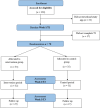Effects of an intervention targeting social media app use on well-being outcomes: A randomized controlled trial
- PMID: 39853856
- PMCID: PMC11758673
- DOI: 10.1111/aphw.12646
Effects of an intervention targeting social media app use on well-being outcomes: A randomized controlled trial
Abstract
Background: Interventions targeting social media use show mixed results in improving well-being outcomes, particularly for persons with problematic forms of smartphone use. This study assesses the effectiveness of an intervention app in enhancing well-being outcomes and the moderating role of persons' perceptions about problematic smartphone use (PSU).
Methods: In a randomized controlled trial, N = 70 participants, allocated to the intervention (n = 35) or control condition (n = 35), completed weekly online surveys at baseline, post-intervention, and follow-up. Participants from the intervention condition received personalized full-screen nudges to reduce their social media app use. This secondary analysis focuses on the repeatedly assessed outcomes well-being, positive affect, negative affect, and perceived stress. Linear mixed models were computed.
Results: No significant time x group effects were found, but intervention condition participants reported higher well-being and lower negative affect and stress levels at follow-up. Only one significant moderation was found, indicating that participants reporting higher PSU levels benefited more from the intervention in reducing stress.
Conclusions: The intervention was partly effective and particularly beneficial in reducing stress among smartphone users with higher PSU, highlighting the need to tailor interventions. Present findings need to be replicated by future research using a larger sample size.
Keywords: affect; digital disconnection; digital nudge; intervention app; problematic smartphone use; stress.
© 2025 The Author(s). Applied Psychology: Health and Well‐Being published by John Wiley & Sons Ltd on behalf of International Association of Applied Psychology.
Conflict of interest statement
LM was employed as a working student at the Wellspent GmbH during the time of the intervention period. CR is co‐founder of the Wellspent GmbH.
Figures


Similar articles
-
A digital intervention to improve mental health and interpersonal resilience for young people who have experienced online sexual abuse: the i-Minds non-randomised feasibility clinical trial and nested qualitative study.Health Soc Care Deliv Res. 2025 Jul;13(28):1-27. doi: 10.3310/THAL8732. Health Soc Care Deliv Res. 2025. PMID: 40754856
-
Mobile health (m-health) smartphone interventions for adolescents and adults with overweight or obesity.Cochrane Database Syst Rev. 2024 Feb 20;2(2):CD013591. doi: 10.1002/14651858.CD013591.pub2. Cochrane Database Syst Rev. 2024. PMID: 38375882 Free PMC article.
-
Smartphone-Based Intervention Targeting Norms and Risk Perception Among University Students with Unhealthy Alcohol Use: Secondary Mediation Analysis of a Randomized Controlled Trial.J Med Internet Res. 2025 Feb 6;27:e55541. doi: 10.2196/55541. J Med Internet Res. 2025. PMID: 39914807 Free PMC article. Clinical Trial.
-
Prescription of Controlled Substances: Benefits and Risks.2025 Jul 6. In: StatPearls [Internet]. Treasure Island (FL): StatPearls Publishing; 2025 Jan–. 2025 Jul 6. In: StatPearls [Internet]. Treasure Island (FL): StatPearls Publishing; 2025 Jan–. PMID: 30726003 Free Books & Documents.
-
Home treatment for mental health problems: a systematic review.Health Technol Assess. 2001;5(15):1-139. doi: 10.3310/hta5150. Health Technol Assess. 2001. PMID: 11532236
References
-
- Aagaard, J. (2021). ‘From a small click to an entire action’: Exploring students' anti‐distraction strategies. Learning, Media and Technology, 46(3), 355–365. 10.1080/17439884.2021.1896540 - DOI
-
- Aalbers, G. , vanden Abeele, M. M. , Hendrickson, A. , De Marez, L. , & Keijsers, L. (2022). Caught in the moment: Are there person‐specific associations between momentary procrastination and passively measured smartphone use? Mobile Media & Communication, 10(1), 115–135. 10.1177/2050157921993896 - DOI
Publication types
MeSH terms
Grants and funding
LinkOut - more resources
Full Text Sources
Medical

